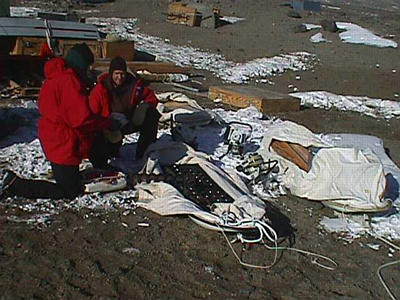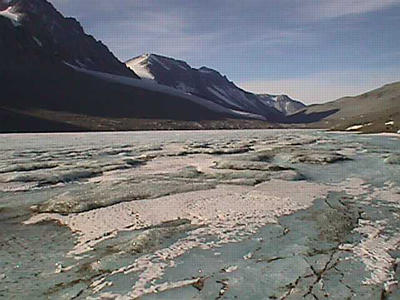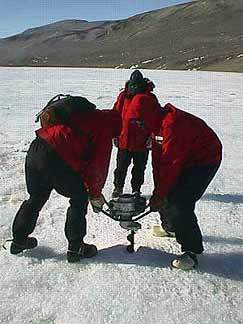
|
|
4 November, 1998
I awoke at 6:45 am this morning slightly chilled, so I decided to get up
to get warmed in the Jamesway (that, and I didn't know when everyone
else would be "up and at 'em"). I was the second one up, so I ate
breakfast and had some hot tea. By 10:15 in the morning, everyone had
woken up, had breakfast, and were out gathering equipment for the day.
Since Nina, Chris, Mark, and I were going to be drilling and coring
(taking ice cores out of the ice at different depths), we had to pack
banana sleds (long sleds used for hauling equipment away from camp) with
the equipment we needed (meter-long drill bits, power heads, coring
equipment). We also had to get our individual packs ready with snacks,
water, and a pee bottle. (Remember, you can't leave ANY waste!)
At 12:00 we had a quick lunch to rehydrate and reenergize. It is very
important to keep hydrated in cold temperatures. It allows your body to
maintain its temperature and to keep your bodily functions going.
During the day today, it reached -12 degrees C...it was sunny but windy.
From 1:00 to 5:00 pm we drilled 10 holes in the ice and attempted to
core the ice. We had some difficulty with the power heads that powered
the rotation of the drills. They refused to start, and after they
started, they would conk out after a bit. The corer was having problems
and refused to do the job at the end, so we had to come in and get it
fixed. On a break out on the ice, Chris took us over to a distant
"rock" which upon closer inspection, turned out to be a mummified seal.
Mummified seals are not an uncommon occurrence in the Dry Valleys. They
have been found as far inland as 40 km (which is remarkable for how
awkward seals look on land). They lose their sense of direction, and
instead of heading back to the sea, they go inland, only to freeze-dry
to death. Because of the colder temperatures and dry air, their
decomposition rate is slow. They are eroded away by the wind just like
the rocks in the Dry Valleys. Once, an Adelie penguin was found here.
Our camp surroundings are unbelievable. Other than the sound of the
wind tugging and whistling past my hood, Lake Bonney is refreshingly
quiet. Tall, snow-covered mountains surround our camp. Huge glaciers
spill down the sides of the mountains. Every once in a while you can
hear a glacier "calve", and a huge chunk breaks off to go flying down
the mountain. The rocks are all different shapes here...they've been
eroded in the wind. They are called ventifacts, and their windward
sides have been polished smooth. The Dry Valleys were formed when the
terrain uplifted faster than the glaciers could cut their way through
them. Eventually the glaciers were stopped by high necks at the head of
each valley. There is very little snow where our camp is because of a
number of factors-- wind, extreme dry air, and solar radiation. The
snow simply sublimates (goes directly into the air as vapor). There is
ice on the lake, but the ice formations are very different. Around the
edges of the lake is a very clear, deep, blue ice called "moat" ice.
This is the ice that will melt later in the summer. The rest of the
lake is covered by a white, very rough ice. Some of the ridges and
valleys in the ice can be up to a foot tall. This is because of the
wind. This is also the ice that will get slushy on top during the
summer but never melt all of the way through because it is about 4 - 5
meters thick!
Scientists believe that the Dry Valleys are the best representation of
what the terrain on Mars might look like. That's why NASA did extensive
research here prior to the launch of the Viking probe to Mars.
Back to my journaling of my day...After fixing the corer, Chris and Nina
returned to the ice. I promised that I would make dinner for the group
again. I cleaned up the Jamesway and swept it out (wow, it gathers a
lot of dust in here because of the loads of dirt outside!)...and I just
can't sweep it outside...I have to collect it in a dustpan and place in
the construction debris can. I collected ice berries again today and
made dinner (steak fajitas, chips/salsa, refried beans, and cherry
turnovers). It's amazing what you can cook down here!
John and Ed went to the West Lobe of Lake Bonney today to check their
thermocouplers on the ice. They have temperature probes set in the ice
every 1/2 meter from 1/2 meter to 4.5 meters. The light probe is set at
10 meters down (which is in the water). They have a data logger in a
box in which all of the temperature and light sensors plug into. The
data logger records the data from these sensors every 20 minutes. Small
rectangular cans collect and store the data throughout the year. By
measuring these things, they are determining how much liquid water is in
the ice and what drives photosynthesis and productivity. They need to
determine how much light is actually reaching through the ice and
through the water in order to be able to discuss photosynthesis.
We ate dinner as soon as everyone had come in off of the ice (about 8:00
pm). Ed, Chris, and I tried the watercolor experiment again but were
unsuccessful. Bedtime came at 11:30 pm...the temperature only dropped
to about -15 C at night. I stole an extra sleeping bag from the
Jamesway and put it over the one that I was issued. Boy, I slept like a
baby!

Chris and John getting together the banana sleds and drilling equipment-- the power heads that we use to drill the ice are in between the 2 banana sleds.

This is what is called moat ice (the ice around the lake that will melt in the summer). It is what we get ice berries from, and it's very smooth and slippery. We wear crampons (metal blade devices we hook onto the bottoms of our boots) when working on the ice.

Lake Bonney has many types of ice on its surface-- the smooth, clear blue moat ice around its edges and the white, rough ice in the middle. It really is quite spectacular.

Chris and Mark drilling 4-inch diameter holes in the ice. Nina is in the background.

The mummified seal that we found laying on the ice. Chris said that it was here when he was last here in '96.
Contact the TEA in the field at
.
If you cannot connect through your browser, copy the
TEA's e-mail address in the "To:" line of
your favorite e-mail package.
|
